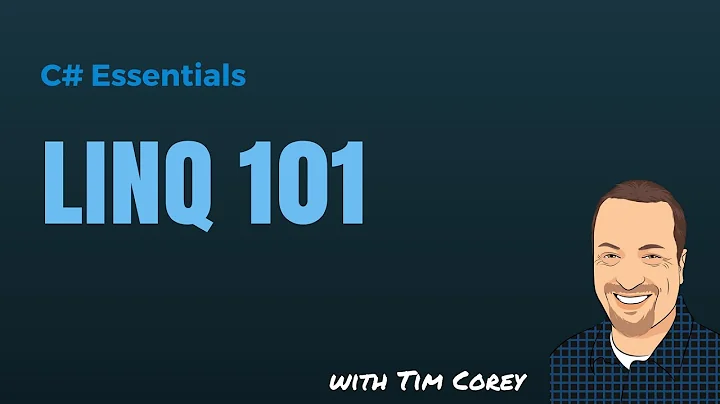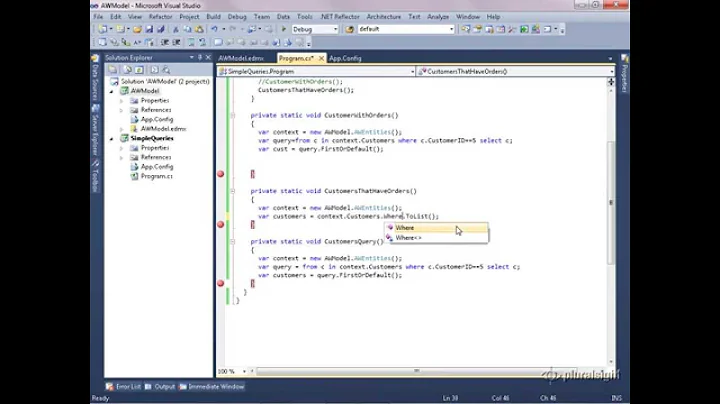LINQ to Entities projection of nested list
11,129
Solution 1
You don't. You have to do this part in L2O.
So you could do:
var q = (from MyClassTable mct in this.Context.MyClassTableSet
select new // note anonymous type; important!
{
ID = mct.ID,
Name = mct.Name,
Things = (from MyOtherClass moc in mct.Stuff
where moc.IsActive
select new MyOtherClass
{
ID = moc.ID,
Value = moc.Value
}
}).AsEnumerable();
MyClass myClass = (from mct in q
select new MyClass
{
ID = mct.ID,
Name = mct.Name,
Things = mct.Things.ToList()
}).FirstOrDefault();
There's no way to do this in one query.
Solution 2
I'm not sure what exactly your asking about, but List<T> does implement IEnumerable<T> (which is just an interface for an enumerable sequence).
A code that will do your projection and have Things be a List instead of an IEnumerable would use the ToList() operator, which creates a List<T> from any IEnumerable<T> this:
MyClass myClass = (from MyClassTable mct in this.Context.MyClassTableSet
select new MyClass
{
ID = mct.ID,
Name = mct.Name,
Things = (from MyOtherClass moc in mct.Stuff
where moc.IsActive
select new MyOtherClass
{
ID = moc.ID,
Value = moc.Value
}).ToList()
}).FirstOrDefault();
Related videos on Youtube
Comments
-
ctorx about 2 years
Assuming these objects...
class MyClass { int ID {get;set;} string Name {get;set;} List<MyOtherClass> Things {get;set;} } class MyOtherClass { int ID {get;set;} string Value {get;set;} }How do I perform a LINQ to Entities Query, using a projection like below, that will give me a List? This works fine with an IEnumerable (assuming MyClass.Things is an IEnumerable, but I need to use List)
MyClass myClass = (from MyClassTable mct in this.Context.MyClassTableSet select new MyClass { ID = mct.ID, Name = mct.Name, Things = (from MyOtherClass moc in mct.Stuff where moc.IsActive select new MyOtherClass { ID = moc.ID, Value = moc.Value }).AsEnumerable() }).FirstOrDefault();Thanks in advance for the help!
-
ctorx almost 14 yearsToList() on a LINQ to Entities Query is not supported, which is why I have asked this question.
-
Sam almost 14 yearsIs there some reference for this? MSDN's own LINQ to Entities shows you can in fact use ToList. msdn.microsoft.com/en-us/library/bb896246.aspx?ppud=4
-
ctorx almost 14 yearsYou can use ToList() on the result of a query, but now within a query. In the example of your link, the ToList() is added to the end of a LINQ expression. In my code, it is embedded within the expression, hence, not supported.
-
Sam almost 14 yearsGotcha, the root cause is LINQ to Entities cannot instantiate the
List<T>, or any IEnumerable for that matter, inside of a query. mosesofegypt.net/post/… -
ctorx almost 14 yearsThanks, I just figured this out too.







![How to use LINQ in CSharp (Linq to Entity & Linq to Object) [April 2021]](https://i.ytimg.com/vi/bFknTKsAGZk/hqdefault.jpg?sqp=-oaymwEcCOADEI4CSFXyq4qpAw4IARUAAIhCGAFwAcABBg==&rs=AOn4CLAqt6ntFgOgadId6BRbiPOGDO0csw)